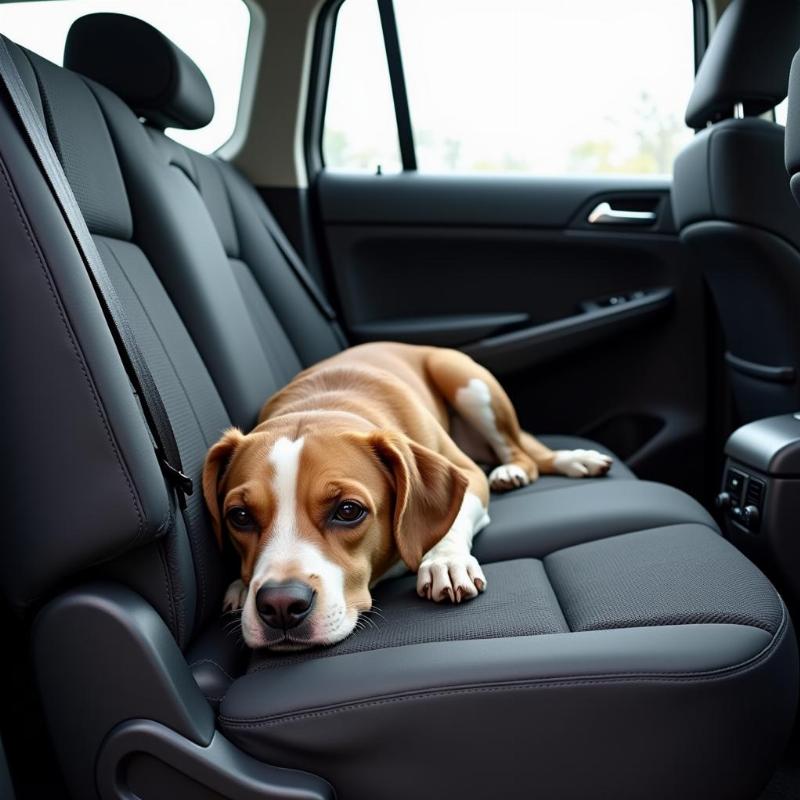If you’ve ever taken your dog on a car ride, you’ve probably noticed them panting. While some panting is normal, excessive panting in the car can indicate a variety of underlying issues, from simple anxiety to more serious medical concerns. Understanding why your dog is panting so much in the car is crucial for ensuring their safety and comfort during travel. This article will explore the common reasons for canine car panting, offer practical solutions, and help you determine when it’s time to seek veterinary care.
Is Car Panting Normal for Dogs?
A little bit of panting is perfectly normal, especially in warm weather. Dogs don’t sweat like humans do, so they pant to regulate their body temperature. However, excessive or labored panting, accompanied by other signs like restlessness, whining, drooling, or vomiting, can be a sign of something more serious.
Anxiety and Stress: The Most Common Culprits
The most frequent reason for excessive dog panting in the car is anxiety or stress. Car rides can be overwhelming for some dogs, especially if they associate them with negative experiences like vet visits or being separated from their owners. Motion sickness can also contribute to anxiety.
Signs of Anxiety in the Car
Look for these signs to determine if your dog’s panting is anxiety-related:
- Whining or barking: Vocalizations are a clear sign of distress.
- Pacing or restlessness: Inability to settle down suggests discomfort.
- Trembling or shaking: These are physical manifestations of fear.
- Destructive behavior: Scratching at the car door or chewing on seatbelts.
- Excessive drooling or vomiting: These can be signs of nausea related to motion sickness or anxiety.
Other Potential Reasons for Panting
While anxiety is the most common cause, it’s not the only one. Other potential reasons include:
Heatstroke: A Serious Danger
Cars heat up quickly, even on mild days. Make sure your dog has adequate ventilation and never leave them unattended in a parked car, even for a short period.
Underlying Medical Conditions
Certain medical conditions, such as heart or respiratory problems, can cause increased panting. If your dog’s panting seems excessive or unusual, consult your veterinarian.
 Dog experiencing motion sickness in car
Dog experiencing motion sickness in car
How to Help a Panting Dog in the Car
Here are some practical tips to help reduce your dog’s panting and make car rides more enjoyable:
- Create a Comfortable Environment: Ensure proper ventilation, a comfortable temperature, and a familiar-smelling blanket or toy.
- Desensitization and Counter-Conditioning: Gradually introduce your dog to the car in short, positive sessions, associating it with treats and praise.
- Motion Sickness Remedies: Consult your veterinarian about medications or natural remedies for motion sickness.
- Safety First: Secure your dog in a crate or with a dog seatbelt to prevent injury in case of sudden stops.
- Breaks and Exercise: On long trips, take frequent breaks for your dog to stretch their legs, relieve themselves, and get some fresh air.
Conclusion
Understanding the reasons behind your dog’s panting in the car is essential for their well-being. By addressing their anxiety, ensuring their safety, and creating a comfortable environment, you can transform car rides from a stressful experience into a pleasant one for both you and your furry friend. If the panting persists or seems excessive, don’t hesitate to consult your veterinarian.
FAQ
- Is it normal for my dog to pant a little in the car? Yes, some panting is normal, especially in warm weather.
- How can I tell if my dog is anxious in the car? Look for signs like whining, pacing, trembling, and excessive drooling.
- What can I do if my dog gets car sick? Consult your veterinarian about medications or natural remedies.
- Is it safe to leave my dog in a parked car? No, never leave your dog unattended in a parked car, even for a short time.
- When should I consult a veterinarian about my dog’s panting? If the panting is excessive, labored, or accompanied by other symptoms.
- How can I make car rides less stressful for my dog? Create a comfortable environment, use desensitization and counter-conditioning, and ensure their safety.
- What are some signs of heatstroke in dogs? Excessive panting, rapid heartbeat, weakness, vomiting, and collapse.
Related Articles
Beautdogs.us is your premier destination for all things dog-related in the US. We offer expert advice on dog breeds, care, and products, catering to both new and experienced dog owners. Our team of experts is dedicated to providing reliable, comprehensive, and engaging content to enhance the bond between you and your canine companion. From understanding why your dog is panting so much in the car to finding the perfect breed for your lifestyle, Beautdogs.us is your trusted source. Contact us today for any inquiries! Email: [email protected], Phone: +1 501-555-7529.